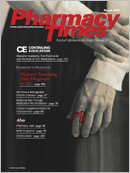Publication
Article
Pharmacy Times
generic times: product profiles
Author(s):
Sodium SulfacetamideTopical Lotion 10%
The arts and sciences often cross inunexpected ways. Paul Fildes, the sonof an illustrator for Charles Dickens, becameknown as the father of Britishmicrobiology while creating biologicalweapons during World War II. Duringthese investigations, he formulated atheory with Donald Woods describing aproposed action for sulfonamide drugs.This premise was based on the structuralsimilarity between sulfonamidesand para-aminobenzoic acid (PABA)and the use of that similarity to interruptessential functions in bacterial cellgrowth. The Woods-Fildes theory is stillaccepted today.
Sulfonamides have several dosageforms and many indications. Topicaladministration results in about 4% percutaneousabsorption, and this amountcreates effective antibiotic activityagainst Propionbacterium acnes whilelimiting potential systemic resistance.
The common skin disease known asacne vulgaris knows no age boundaries,but it is most fond of the adolescentdermis. Althoughnotfatal, acne canoften result inphysical andemotionalscarring. Evenin the light ofgeneral concernsoverbacterialresistance,topical sulfacetamidefor acne generatesover 5 million prescriptions annually.Among the therapies in currentvogue is a 10% concentration of sulfacetamidein lotion form. Sodium sulfacetamidetopical lotion is now availablein a 10% concentration from PrascoLaboratories and is AB-rated to thebrand product Klaron (Dermik Laboratories,a business of sanofi-aventisUS LLC).
Pharmacology
In addition to the competitive antagonismto PABA as a major inhibitor tobacterial cell growth, the sulfur moleculeitself serves as a direct keratolyticagent and inhibits the development offree fatty acids, part of the inflammatoryprocess surrounding acne vulgaris.
Administration
The lotion should be shaken wellbefore each use to evenly disperse thedrug. The patient should apply a thinfilm to the areas affected by the acneeruptions once to twice a day. Handwashing is encouraged before andafter each application.
Safety Profile
Adverse effects from topical sulfacetamideare infrequent, with studiesreporting incidences of fewer than 2%.These generally involve localized irritation,erythema, stinging, and burning.Because it is a sulfonamide-based compound,the potential for severe reactions,such as Stevens-Johnson syndromeor toxic epidermal necrolysis,should be considered. Sodiummetabisulfite is also part of the formulation,and this sulfite has been implicatedin rare, but nevertheless potentiallysevere, allergic reactions. Allergiesto sulfa drugs represent a contraindicationto the use of topical sulfacetamide.
Outlook
The pathogenesis of acne vulgarisrepresents a collection of causativefactors that promote the inflammatoryeffects of P acnes. Sulfacetamide,while it is becoming less effectiveagainst certain strains of staphylococcus,has not shown diminished activityagainst Propionbacterium in acne.
Trandolapril Oral Tablets
Recent studies continue to reinforcethe value of using angiotensin-convertingenzyme (ACE) inhibitors to reducethe primary end points of cardiovasculardisease, myocardial infarction, andcardiac arrest. Trandolapril is one ofmany ACE inhibitors and has recentlybeen made available in generic form.Trandolapril is available from TevaPharmaceuticals in 1-, 2-, and 4-mgtablets.
Pharmacology
Inhibition of the enzyme that activatesangiotensin results in a diminishedlevel of physiologic aldosterone.This in turn reduces sodium and fluidretention. The inhibition also allows fora shift in balance between angiotensinII and bradykinin, with increases inbradykinin promoting the reduction invascular tone that, in turn, further promotessodium excretion and diuresis.
Additional beneficial actions of ACEinhibition include localized reduction ofthe inflammatory processes that createatherosclerosis within arterialwalls. Although this action may notreverse existing plaque formation, anACE inhibitor may help stabilize thelesion and prevent rupture and itsassociated complications.ACE inhibitors such as trandolaprilmay be used as monotherapy for treatmentof hypertension, but they areoften used in combination with otherantihypertensive agents. In addition,
ACE inhibitors reduce the mortality andclinically significant risk of heart failureamong patients following myocardialinfarction. Hypertensive patients withcomorbid diabetes may benefit fromACE-inhibitor therapy as a means toslow the progression rate of renal diseasein the presence of proteinuria orexisting nephropathy.
Ethnic background has an effect onresponse to ACE inhibitors. AfricanAmericans respond better to monotherapywith diuretics or calcium channelblocking drugs than to ACEinhibitors or β-blockers, and they aremore prone to some serious sideeffects associated with ACE inhibition.The causative mechanism for thiseffect is unclear. When used amongAfrican Americans, trandolapril requiresa higher dose to achieve thesame therapeutic effect.
Dosage and Administration
The general starting dose amongnon-African American patients is 1 mgdaily; African American patients generallyrequire 2 mg daily.
Dosing changes should be made at2-to 3-week intervals. At steady state,the general maintenance dose of trandolaprilis 2 mg to 4 mg, taken oncedaily. Daily doses beyond 8 mg havenot been studied for either safety orefficacy.
To minimize clinically hypotensiveresponses with combination therapy,diuretics should be discontinued 2 to 3days prior to initiating trandolapril. If adiuretic is to be continued, the startingtrandolapril dose should be 0.5 mg daily.
Safety Profile
Based on reports published in 2006,ACE inhibitors administered during thefirst trimester of pregnancy are associatedwith an increase in major congenitalmalformations in the developingfetus. Although ACE inhibitors have notbeen recategorized by the FDA toreflect this information, the currentrecommendation is to discontinue anyACE inhibitor as soon as possible if apatient becomes pregnant. Presently,ACE inhibitors are labeled as pregnancycategory C for the first trimester andcategory D during the second andthird.
The potential for neutropenia andagranulocytosis associated with captoprilhas not become manifest withtrandolapril; leukocyte monitoringshould still be considered in the presenceof collagen vascular disease,however, especially with the existenceof renal impairment.
ACE inhibitors are also associatedwith a rare hepatic syndrome, clinicallymanifesting ascholestatic jaundiceand potentiallyevolving tonecrosis. Potentiallyfatal angioedemamay alsooccur with ACEinhibitors, requiringpatient educationfor the appropriateresponseto anyswelling of theface, larynx, orextremities.
Angioedema isa rare consequenceof ACE-inhibitortreatment,with AfricanAmericans at 4.5times the risk ofdeveloping the conditionover therest of the population.Angioedemacan, however, appearwithout anyother direct correlationto age,sex, dosage, orconcurrent treatment.
In addition, patients with diabetesneed to be instructed on the potentialfor changes in blood glucose levelswhile using an ACE inhibitor. There isalso the potential for pancreatitis duringthis therapy.
Outlook
Affecting physiologic levels ofangiotensin is demonstrating a widevariety of effects, including activity thathas not been predicted by tracing theusual ACE-mediated pathways. Despitethe potential for serious side effects,ACE inhibitors are also being increasinglyexamined for their effects onthrombosis and inflammation withinthe cardiovascular system.
Mr. Middleton is an instructor of pharmacologyat Kellogg Community College in Battle Creek, Mich.







